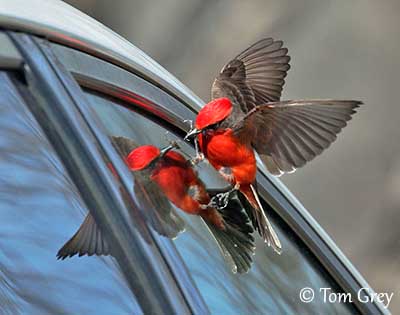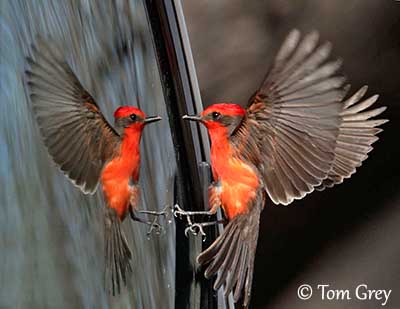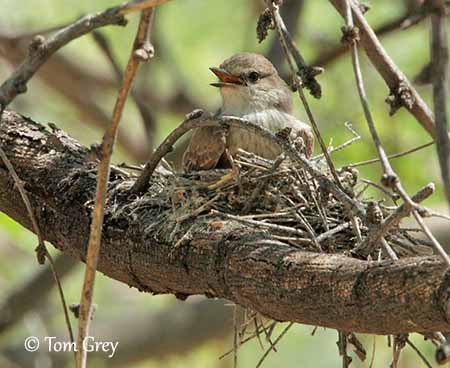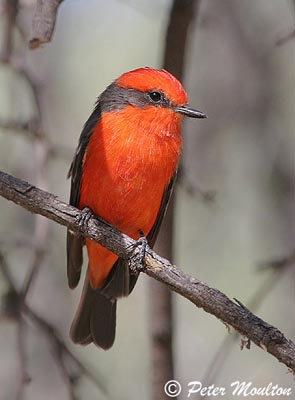
Vermilion Flycatcher
Pyrocephalus rubinus
Passeriforme Order - Tyrannidae Family
BIOMETRICS:
Length: 13-14 cm; Weight: 11-14 g
LONGEVITE : 5 ans
DESCRIPTION:
Vermilion Flycatcher is one of the most spectacular flycatchers of America, as in colours or in courtship displays.
Adult male is mainly red and dark brown. It has bright red crown and underparts. A blackish mask includes lores, eyes, ear-coverts and nape. Back, wings and tail are blackish-brown.

The female lays 2 to 4 white to cream or brown eggs, as soon as nest is built. Incubation lasts about 13 to 15 days, by female alone. She is fed by male at nest. Altricial chicks hatch within 24 hours. Female broods the chicks and both parents feed them. Young fledge at about 13 to 15 days after hatching.
This species usually produces two clutches per season.
DIET:
Vermilion Flycatcher feeds mainly on terrestrial and flying insects, such as grasshoppers, honeybees, beetles and crickets.
PROTECTION / THREATS / STATUS:
Vermilion Flycatcher is probably preyed upon by snakes, racoons, owls and crows, as all small birds.
This species is threatened by habitat loss due to human developments, and pesticides used in urban areas. These birds have few areas in which they can breed, and preservation of both dry and wet riparian areas is a priority for the long term maintenance of this species.
Fr: Moucherolle vermillon
All : Rubintyrann
Esp : Mosqueta Sangre de Toro
Ital : Pigliamosche vermiglio
Russe : Красный тиранн
Sd : Rubintyrann
Photograph by Pete Moulton
His web site : Pete Moulton Photography
Photograph by Marc Chrétien
His website :
MURINUS
Photographs by Tom Grey
His website : Tom Grey's Bird Pictures
Text by Nicole Bouglouan
Sources:
THE HANDBOOK OF BIRD IDENTIFICATION FOR EUROPE AND THE WESTERN PALEARCTIC by Mark Beaman, Steve Madge - C.Helm - ISBN: 0713639601
All About Birds (Cornell Lab of Ornithology)
What Bird-The ultimate Bird Guide (Mitchell Waite)
Wikipedia (Wikipedia, The Free Encyclopedia)
SORA Searchable Ornithological Research Archive (Blair O. Wolf)
Animal Diversity Web (University of Michigan Museum of Zoology)
Bird Web (Seattle Audubon Society)
Immature male has duller plumage than adult male. It resembles female but with brighter underparts, salmon-pink to orange-red.
Immature female is similar to adult female, except on belly and vent which are yellowish.
Juvenile is rather brown on upperparts. Underparts are white, more spotted than streaked with brown on breast, and yellowish tinge on belly.
They reach their sexual maturity at about two years.
Thin, pointed bill is blackish. Eyes are dark brown. Legs and feet are blackish.
VOICE: SOUNDS BY XENO-CANTO
Vermilion Flycatcher’s calls include contact call, a sharp and long “peent” or “pick”; this call may be also used as alarm call. Copulation call is used by female inviting male “tjee-tjee-tjee”, and in aggressive displays or sexual encounters.
Male song is a repeated “ching-tink-a-le-tink” or a “pit-a-see, pit-a-see”. We can also hear a flight song given by male while it rises above the ground during flight displays “t-t-ti-ti-tee-teeur” or “pt-pt-pre-ee-een”.
Songs are uttered from elevated perches and during flight displays.
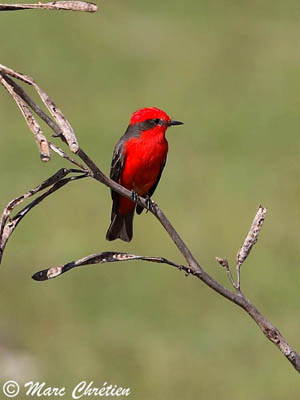
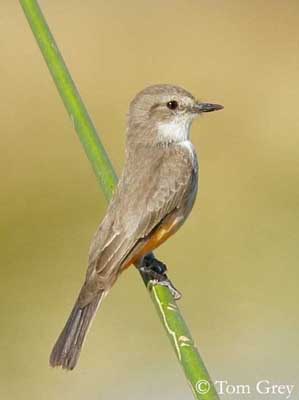
Vermilion Flycatcher performs frequent copulations during nest building. Male often brings large showy insect when flying to female.
They are monogamous and solitary nesters. Male flies around potential nest sites, giving calls to nearby females for attracting them. They fly to each site, crouch, while they flutter their wings. Female chooses a nest-site, ignoring the displaying male. When she accepts, both land at different nest-sites in crouching posture. They can display side by side. Then female may start the nest construction.
Vermilion Flycatcher spends little time on the ground. It is a diurnal species.
FLIGHT:
Vermilion Flycatcher has swift and direct flight with regular wing beats and rare glides. Hunting flight is short and direct, often erratic during pursuits. It may perform acrobatic flight for catching prey, before return to perch. It can also hover briefly for gleaning prey of feeding female at nest during incubation.
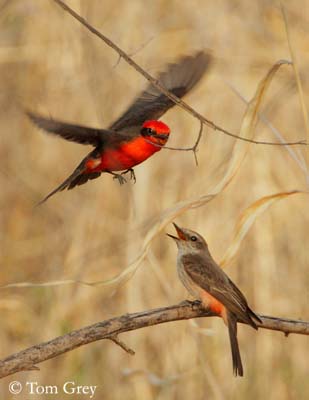
HABITAT:
Vermilion Flycatcher lives in stream sides shrubs, farmlands, desert, savannahs, cultivated areas and riparian woodlands, and usually near water.
Winter range includes open and semi-open areas with hedgerows, scattered trees and bushes, often near water.
RANGE:
Vermilion Flycatcher breeds in southern Arizona, New Mexico and Texas, and widely in Mexico, Central America, South America, and Galápagos Islands.
It is resident in almost all its breeding range. Only US populations migrate or disperse in winter.
BEHAVIOUR:
Vermilion Flycatcher sits and waits for preys. Prey is located from perch, and pursued until capture. Large preys are carried to perch where the bird beats them before eating them. It also catches prey in flight. It pursues and snaps preys in a swift direct flight. If a prey escapes first attack, Vermilion Flycatcher will pursue it with acrobatic chase until capture.
Ground preys are captured from perch, with direct downwards flight, or landing on ground for picking up it.
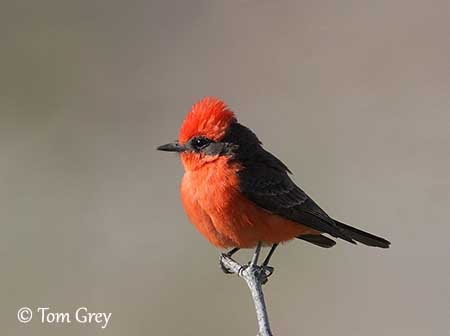
Territorial disputes show the male chasing other males and females of other species, with wings whirring. Male may adopt aggressive attitude with raising crest, pumping and fanning tail, and making some sounds with snapping bill.
The male may fight against its own reflection, excited by the bright red plumage of the "opponent".
